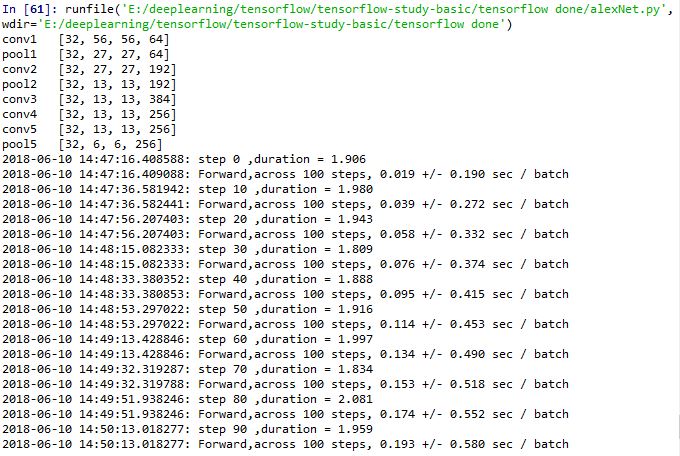概述
AlexNet网络结构对于今天而言并无太多特殊之处,但是它的出现却将我们卷入了深度学习的大潮,具有重要的意义。下面基于tensorflow对alexNet进行了简单的复现,主要是测试了下alexNet网络的运行时间。
# -*- coding: utf-8 -*-
"""
Created on Sun Jun 10 13:54:00 2018
@author: kuangyongjian
"""
from datetime import datetime
import math
import time
import tensorflow as tf
batch_size = 32
num_batches = 100
def print_activations(t):
print(t.op.name,' ',t.get_shape().as_list())
#声明网络的结构
def inference(images):
parameters = []
with tf.name_scope('conv1') as scope:
kernel = tf.Variable(tf.truncated_normal([11,11,3,64],dtype = tf.float32,stddev = 1e-1),name = 'weights')
conv = tf.nn.conv2d(images,kernel,[1,4,4,1],padding = 'SAME')
biases = tf.Variable(tf.constant(0.0,shape = [64],dtype = tf.float32),trainable = True,name = 'biases')
bias = tf.nn.bias_add(conv,biases)
conv1 = tf.nn.relu(bias,name = scope)
print_activations(conv1)
parameters += [kernel,biases]
lrn1 = tf.nn.lrn(conv1,4,bias = 1.0,alpha = 0.001 / 9,beta = 0.75,name = 'lrn1')
pool1 = tf.nn.max_pool(lrn1,ksize = [1,3,3,1],strides = [1,2,2,1],padding = 'VALID',name = 'pool1')
print_activations(pool1)
with tf.name_scope('conv2') as scope:
kernel = tf.Variable(tf.truncated_normal([5,5,64,192],dtype = tf.float32,stddev = 1e-1),name = 'weights')
conv = tf.nn.conv2d(pool1,kernel,[1,1,1,1],padding = 'SAME')
biases = tf.Variable(tf.constant(0.0,shape = [192],dtype = tf.float32),trainable = True,name = 'biases')
bias = tf.nn.bias_add(conv,biases)
conv2 = tf.nn.relu(bias,name = scope)
print_activations(conv2)
parameters += [kernel,biases]
lrn2 = tf.nn.lrn(conv2,4,bias = 1.0,alpha = 0.001 / 9,beta = 0.75,name = 'lrn2')
pool2 = tf.nn.max_pool(lrn2,ksize = [1,3,3,1],strides = [1,2,2,1],padding = 'VALID',name = 'pool2')
print_activations(pool2)
with tf.name_scope('conv3') as scope:
kernel = tf.Variable(tf.truncated_normal([3,3,192,384],dtype = tf.float32,stddev = 1e-1),name = 'weights')
conv = tf.nn.conv2d(pool2,kernel,[1,1,1,1],padding = 'SAME')
biases = tf.Variable(tf.constant(0.0,shape = [384],dtype = tf.float32),trainable = True,name = 'biases')
bias = tf.nn.bias_add(conv,biases)
conv3 = tf.nn.relu(bias,name = scope)
parameters += [kernel,biases]
print_activations(conv3)
with tf.name_scope('conv4') as scope:
kernel = tf.Variable(tf.truncated_normal([3,3,384,256],dtype = tf.float32,stddev = 1e-1),name = 'weights')
conv = tf.nn.conv2d(conv3,kernel,[1,1,1,1],padding = 'SAME')
biases = tf.Variable(tf.constant(0.0,shape = [256],dtype = tf.float32),trainable = True,name = 'biases')
bias = tf.nn.bias_add(conv,biases)
conv4 = tf.nn.relu(bias,name = scope)
parameters += [kernel,biases]
print_activations(conv4)
with tf.name_scope('conv5') as scope:
kernel = tf.Variable(tf.truncated_normal([3,3,256,256],dtype = tf.float32,stddev = 1e-1),name = 'weights')
conv = tf.nn.conv2d(conv4,kernel,[1,1,1,1],padding = 'SAME')
biases = tf.Variable(tf.constant(0.0,shape = [256],dtype = tf.float32),trainable = True,name = 'biases')
bias = tf.nn.bias_add(conv,biases)
conv5 = tf.nn.relu(bias,name = scope)
parameters += [kernel,biases]
print_activations(conv5)
pool5 = tf.nn.max_pool(conv5,ksize = [1,3,3,1],strides = [1,2,2,1],padding = 'VALID',name = 'pool5')
print_activations(pool5)
return pool5,parameters
#计算输入到得到pool5的运行时间
def time_tensorflow_run(session,target,info_string):
num_steps_burn_in = 10
total_duration = 0.0
total_duration_squared = 0.0
for i in range(num_batches + num_steps_burn_in):
start_time = time.time()
_ = session.run(target)
duration = time.time() - start_time
#每迭代十次计算一次平均时间
if i >= num_steps_burn_in:
if not i % 10:
print('%s: step %d ,duration = %.3f'%
(datetime.now(),i - num_steps_burn_in,duration))
total_duration += duration
total_duration_squared += duration * duration
mn = total_duration / num_batches
vr = total_duration_squared / num_batches - mn * mn
sd = math.sqrt(vr)
print('%s: %s,across %d steps, %.3f +/- %.3f sec / batch'%
(datetime.now(),info_string,num_batches,mn,sd))
def run_benchmark():
with tf.Graph().as_default():
image_size = 224
images = tf.Variable(tf.random_normal([batch_size,
image_size,
image_size,
3],
dtype = tf.float32,
stddev = 1e-1))
pool5,parameters = inference(images)
init = tf.global_variables_initializer()
sess = tf.Session()
sess.run(init)
time_tensorflow_run(sess,pool5,'Forward')
run_benchmark()
若有不当之处,请指教,谢谢!
最后
以上就是敏感大船为你收集整理的tensorflow学习系列五:AlexNet的全部内容,希望文章能够帮你解决tensorflow学习系列五:AlexNet所遇到的程序开发问题。
如果觉得靠谱客网站的内容还不错,欢迎将靠谱客网站推荐给程序员好友。
本图文内容来源于网友提供,作为学习参考使用,或来自网络收集整理,版权属于原作者所有。








发表评论 取消回复